I’ve often expressed my ambivalence to the tea category that is puerh. Sometimes, though, a story about it demands my attention. And most of those times, the story isn’t even mine. Even stranger still? A few of those stories focus on the puerh itself, and the journey it went through.
This is one such story.
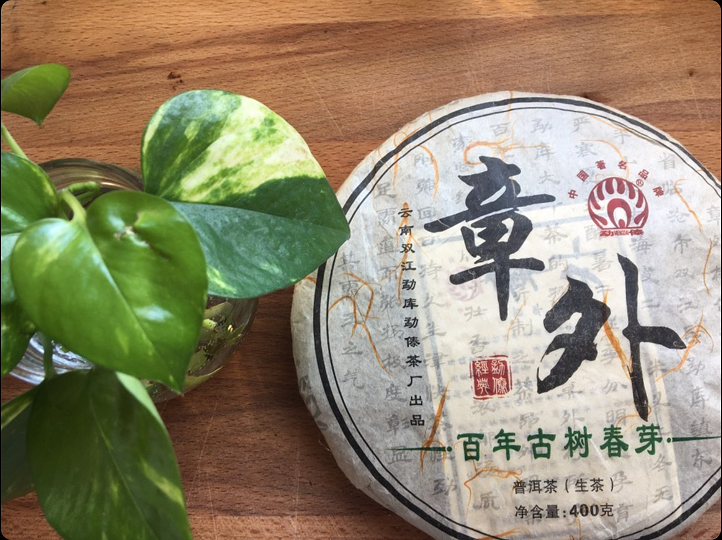
Thanks to social media and the global reach of the tea community, I’m often put in contact with people from all walks of life. Each is on a step of their tea journey. Diana is one of those—a Mexican expat, married to an Italian, living in Italy. Somehow—coming from a country of coffee drinkers, moving to a country of even more passionate coffee drinkers—she came to tea appreciation.
On a random afternoon . . . well, for her it was an afternoon; for me, it was midnight. But that’s beside the point. Anyway, one random [Italian] afternoon, we chatted about our respective tea nooks. She lamented that hers wasn’t as . . . crowded as mine. Frankly, I wish mine looked as pristine as hers did, as opposed to the close-to-erupting volcano that was my closet.
Examining the picture more closely, I noticed something out of place in her collection. A puerh bing cha (“tea cake”) rested against the far left corner of the shelf. Naturally, I asked her about it. She said she got it as a gift from a friend in London. My obvious follow-up, “Let me see.”
Nothing on the front of the wrapper gave me any indication of where it came from. I asked her to turn it over. That turned up even less, save for the sticker that held the wrapper in place. In English letters, it read: “Meng Dai”.

I Googled it.
The only queries that came up were mentions of a factory in the Mengku region of Lincang County, Yunnan Province, China. I tried teas from that region before, possibly even from that factory, but I wasn’t sure. At best, I was a puerh casual.
Squinting, I looked more closely at the edge of the wrapper in the photograph, and then zoomed in further. In red letters, I saw a year listed: 2011. Whether that was the pressing date or the plucking date, I couldn’t tell. Given that it was a factory cake, likely the former.
I asked her if she could find any other Roman numerals on the wrapper. Only thing that turned up were puerh registry codes, no recipe information. We had reached an impasse, and neither of us knew Mandarin. It was time we consult others with more informed puerh opinions. I turned to the Facebook “Puerh Tea Club” group.
And, man, they were thorough.
They asked and answered any queries I put forth. The next phase was probably going to be the most challenging. They asked to see the leaf material. That meant: I had to ask Diana to pry open the cake wrapper. I told her to start with the sticker; she did so.
Gingerly, she was able to peel it pack and unwrap the cake, revealing neatly pressed brown and gold leaves and buds. In other words, the appearance of an almost-decade-old sheng puerh. When I posted the pictures to the puerh club, they surmised the leaf material (based on wrapper info and visual display) was likely standard dashu (“big tree”) sheng (“raw”) material. The typical plucking standard for a normal plantation-to-factory sheng puerh tea cake.
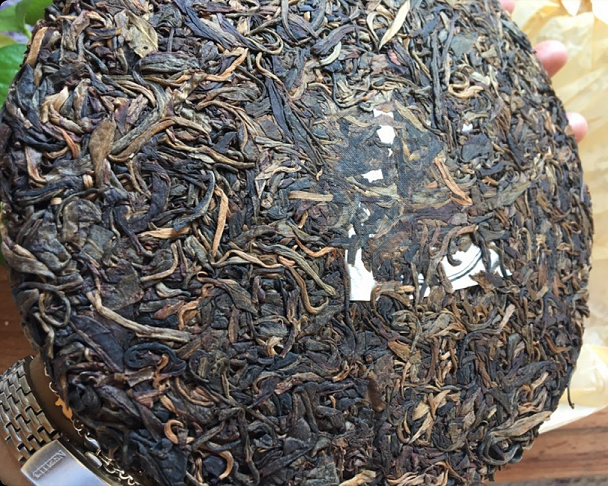
The only thing that threw a wrench in that theory was what the wrapper claimed the leaf material was. The Mandarin translation mentioned that the cake was from ancient tree (“gushu”) material. But then it contradicted that by claiming that gushu was defined as any tree that was 100+ years old. Mmmm, no. Maybe 400+, but not a “mere” century. My best guess? Mushu leaf material. Meaning: tea trees that were young-ish, but grown from clones or grafts from ancient trees. The only other sheng puerhs I tried from Mengku were made from such material.
Upon smelling the leaf, Diana and her husband noted a strong earthy aroma. Since she didn’t own a puerh knife, she opted for the next best thing—an ornate letter opener.
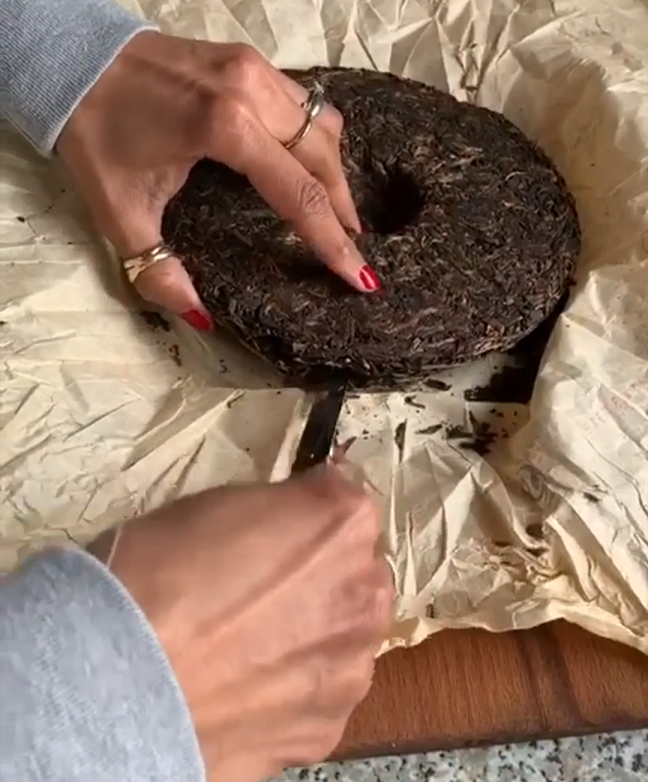
Per my (overly) emphatic instruction, she used it to chisel from the edge. Both planned to brew some up that afternoon, and would get back to be on how it was. I heard from her the next day.
She mentioned that she adhered to shorter steeps, took my advice to eat something beforehand, and shared it with her tiny family. The steam aroma off the brew—they mentioned—smelled like cooked fish, but that (luckily) didn’t translate to taste. She and her husband said it tasted like a combination of roasted chestnuts and some sort of savory Mediterranean fruit I’d never heard of.
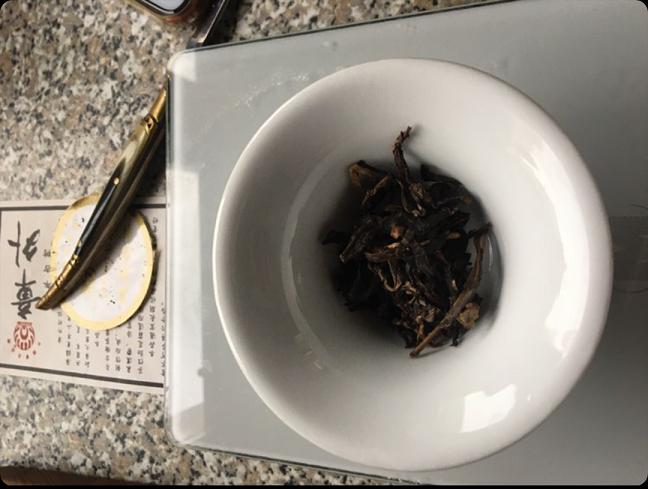
After six infusions, both said they felt light-headed, but in a calm and relaxed sort of way. From the way she described it, they were obviously tea drunk. Strange, she said, since they’d never felt that before. Her five-year-old son even begged for some . . . and liked it!
However, there was one more piece of the puzzle we needed. How did her friend come across this cake? She zapped off a message to the friend, and came back to me with the results a couple of days later.
Her bing cha had a lot to say:
The friend made a trip to China almost a decade ago, and—while in Shanghai—was dragged by an acquaintance to a mysterious “tea alley”. She picked up the cake at the urging of an acquaintance, but never dipped into it, even when she returned to London. On a visit, she passed it on to Diana in Italy, and from there, it followed her and her little family as they moved from one Italian city to another.
But where did the puerh cake originally come from?
Best estimates chock it up to being 2010 or 2011 spring leaf-‘n-bud material plucked in the Dong Ban Shan (“mountain”) area near Bing Dao village in the aforementioned Mengku region of Lincang County. The sheng maocha (“unfinished raw tea”) material was processed and pressed at the Meng Dai factory in Mengku, and then somehow made its way to a random tea shop in Shanghai. It was picked up by a London tourist where it rested, before being passed on to a Mexican expat in Italy. Only to finally be opened and drunk at the urgings of an almost-middle-aged man in the northwestern United States.
That is a helluva tea travel tale.
While I sometimes express indifference to puerh, I can’t deny a certain fascination with it. No two puerhs are alike, whether or not they came from the same region or factory. Depending on where a batch ends up, how it’s aged, the environment it resides in, the flavor profiles change with the chapters in its story. Its character develops, like a certain Mengku cake whose journey showed up in its palatial delivery. Some random midnight; some random afternoon.
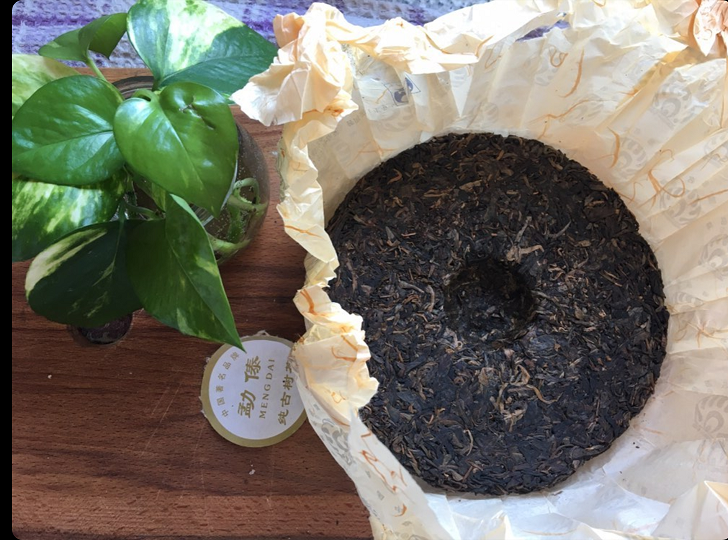
All photos provided by Diana and family.
Leave a Reply